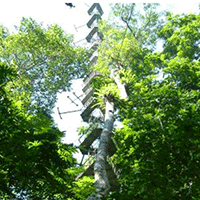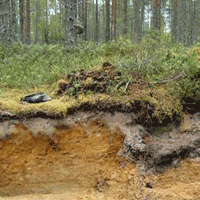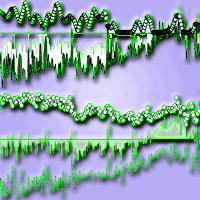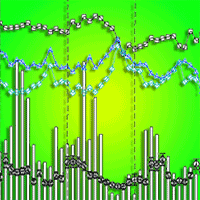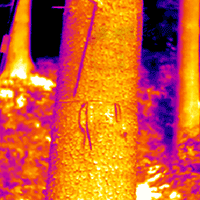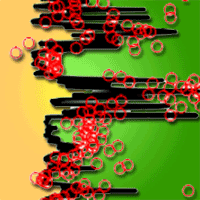Temperature change is an important environmental variable for global change sciences since it largely affects the physiology of plants in forest ecosystems. Canopy temperature depression (CTD) - the result of the deviation of the air temperature (Ta) from the plant canopy surface temperature (Tc) - varies depending on the meteorological and environmental conditions of the forests. Here, we evaluated the differences in CTD between a rubber plantation (RP) and a tropical rainforest (TR) in Xishuangbanna, southwestern China across the various time series of the period of 2011 to 2015. The mean maximum CTD values at the TR site and the RP site were 2.4°C and 0.6°C at diurnal level, 1.3°C and -0.5°C at monthly level, 0.6°C and -0.8°C at seasonal level and 5.6°C and 0.2°C at yearly time series level, respectively, while they were only significant (p < 0.01) in the diurnal time series. There was a significant (p < 0.01) negative linear relationship between CTD and global radiation (Q) in both sites at diurnal level and a significant (p < 0.05) negative linear relationship in the RP site at monthly time series level. A significant (p < 0.05) positive linear relationship between CTD and precipitation (P) at the RP site was found at diurnal level, as well as a significant (p < 0.01) positive linear relationship in the TR site at monthly time series level. The variation of CTD was critical for these two sites and largely depended on the amount of global radiation and the precipitation, while it will mainly affect the physiological variables. This study may prove useful for assessing the physiological response in terms of high temperature and drought conditions to regional and global change.
Keywords
, , , ,
Citation
Tay Zar Myo S, Zhang Y, Song Q-H, Deng Y, Fei X, Zhou R, Lin Y, Zhou L, Zhang P (2019). Analysis of canopy temperature depression between tropical rainforest and rubber plantation in Southwest China. iForest 12: 518-526. - doi: 10.3832/ifor3101-012
Academic Editor
Claudia Cocozza
Paper history
Received: Mar 18, 2019
Accepted: Sep 10, 2019
First online: Dec 09, 2019
Publication Date: Dec 31, 2019
Publication Time: 3.00 months
© SISEF - The Italian Society of Silviculture and Forest Ecology 2019
Open Access
This article is distributed under the terms of the Creative Commons Attribution-Non Commercial 4.0 International (https://creativecommons.org/licenses/by-nc/4.0/), which permits unrestricted use, distribution, and reproduction in any medium, provided you give appropriate credit to the original author(s) and the source, provide a link to the Creative Commons license, and indicate if changes were made.

Breakdown by View Type
(Waiting for server response...)
Article Usage
Total Article Views: 44563
(from publication date up to now)
Breakdown by View Type
HTML Page Views: 38496
Abstract Page Views: 2944
PDF Downloads: 2195
Citation/Reference Downloads: 11
XML Downloads: 917
Web Metrics
Days since publication: 2215
Overall contacts: 44563
Avg. contacts per week: 140.83
Article Citations
Article citations are based on data periodically collected from the Clarivate Web of Science web site
(last update: Mar 2025)
Total number of cites (since 2019): 1
Average cites per year: 0.14
Publication Metrics
by Dimensions ©
Articles citing this article
List of the papers citing this article based on CrossRef Cited-by.
(1)
Ahlheim M, Börger T, Frör O (2015)Replacing rubber plantations by rain forest in Southwest China who would gain and how much? Environmental Monitoring and Assessment. 187.
CrossRef |
Gscholar
(2)
Akpootu DO, Aruna S (2013)Diurnal and seasonal variations of global solar radiation in Akure, Ondo State, South Western Nigeria. The International Journal of Engineering and Science 2 (12): 80-89.
Online |
Gscholar
(3)
Amani I, Fischer RA, Reynolds MP (1996)Canopy temperature depression association with yield of irrigated spring wheat cultivars in a hot climate. Journal of Agronomy and Crop Science 176: 119-129.
CrossRef |
Gscholar
(4)
Balota M, Payne WA, Evett SR, Lazar MD (2007)Canopy temperature depression sampling to assess grain yield and genotypic differentiation in winter wheat. Crop Science 47: 1518-1529.
CrossRef |
Gscholar
(5)
Balota M, Payne WA, Evett SR, Peters TR (2008)Morphological and physiological traits associated with canopy temperature depression in three closely related wheat lines. Crop Science 48: 1897-1910.
CrossRef |
Gscholar
(6)
Bonan GB (2008)Forests in flux forests and climate of forests climate benefits change, and the climate benefit of forests. Science 320: 1444-1449.
CrossRef |
Gscholar
(7)
Borchert R (1998)Responses of tropical trees to rainfall seasonality. Climatic Change 39: 381-393.
CrossRef |
Gscholar
(8)
Brown MB, Forsythe AB (1974)The small sample behavior of some statistics which test the equality of several means. Technometrics 16 (1): 129-132.
CrossRef |
Gscholar
(9)
Cohen Y, Alchanatis V, Meron M, Saranga Y, Tsipris J (2005)Estimation of leaf water potential by thermal imagery and spatial analysis. Journal of Experimental Botany 56: 1843-1852.
CrossRef |
Gscholar
(10)
Conaty WC, Mahan JR, Neilsen JE, Tan DKY, Yeates SJ, Sutton BG (2015)The relationship between cotton canopy temperature and yield, fibre quality and water-use efficiency. Field Crops Research 183: 329-341.
CrossRef |
Gscholar
(11)
DeJonge KC, Taghvaeian S, Trout TJ, Comas LH (2015)Comparison of canopy temperature-based water stress indices for maize. Agricultural Water Management 156: 51-62.
CrossRef |
Gscholar
(12)
Du J, Wang K, Wang J, Ma Q (2017)Contributions of surface solar radiation and precipitation to the spatiotemporal patterns of surface and air warming in China from 1960 to 2003. Atmospheric Chemistry and Physics 17: 4931-4944.
CrossRef |
Gscholar
(13)
Franklin KA, Wigge PA (2014)Temperature and Plant Development. John Wiley and Sons Inc., Oxford, UK, pp. 243.
CrossRef |
Gscholar
(14)
Fuchs M (1990)Infrared measurement of canopy temperature and detection of plant water stress. Theoretical and Applied Climatology 42: 253-261.
CrossRef |
Gscholar
(15)
Giertz S, Junge B, Diekkrüger B (2005)Assessing the effects of land use change on soil physical properties and hydrological processes in the sub-humid tropical environment of West Africa. Physics and Chemistry of the Earth 30: 485-496.
CrossRef |
Gscholar
(16)
Gonzalez-Dugo V, Zarco-Tejada P, Berni JAJ, Suárez L, Goldhamer D, Fereres E (2012)Almond tree canopy temperature reveals intra-crown variability that is water stress-dependent. Agricultural and Forest Meteorology 154 (155): 156-165.
CrossRef |
Gscholar
(17)
Greco M, Chiappetta A, Bruno L, Bitonti MB (2012)In
Posidonia oceanica cadmium induces changes in DNA methylation and chromatin patterning. Journal of Experimental Botany 63: 695-709.
CrossRef |
Gscholar
(18)
Guardiola-Claramonte M, Troch PA, Ziegler AD, Giambelluca TW, Durcik M, Vogler JB, Nullet MA (2010)Hydrologic effects of the expansion of rubber (
Hevea brasiliensis) in a tropical catchment. Ecohydrology 3: 306-314.
CrossRef |
Gscholar
(19)
Hatfield JL, Boote KJ, Kimball BA, Ziska LH, Izaurralde RC, Ort D, Thomson AM, Wolfe D (2011)Climate impacts on agriculture: Implications for crop production. Agronomy Journal. 103: 351-370.
CrossRef |
Gscholar
(20)
Jackson RD, Idso SB, Reginato RJ, Pinter PJ (1981)Canopy temperature as a crop water stress indicator. Water Resources Research 17: 1133-1138.
CrossRef |
Gscholar
(21)
Kim Y, Still CJ, Hanson CV, Kwon H, Greer BT, Law BE (2016)Canopy skin temperature variations in relation to climate, soil temperature, and carbon flux at a ponderosa pine forest in central Oregon. Agricultural and Forest Meteorology 226 (227): 161-173.
CrossRef |
Gscholar
(22)
Kimball BA, White JW, Wall GW, Ottman MJ (2012)Infrared-warmed and unwarmed wheat vegetation indices coalesce using canopy-temperature-based growing degree days. Agronomy Journal 104: 114-118.
CrossRef |
Gscholar
(23)
Kottmann L, Schittenhelm S, Wittich KP, Wilde P (2013)Suitability of canopy temperature depression in a temperate climate with drought-stressed winter rye, determined with three infrared measurement devices. Journal of Agronomy and Crop Science 199: 385-394.
CrossRef |
Gscholar
(24)
Kumar M, Govindasamy V, Rane J, Singh AK, Choudhary RL, Raina SK, George P, Aher LK, Singh NP (2017)Canopy temperature depression (CTD) and canopy greenness associated with variation in seed yield of soybean genotypes grown in semi-arid environment. South African Journal of Botany 113: 230-238.
CrossRef |
Gscholar
(25)
Li H, Aide TM, Ma Y, Liu W, Cao M (2007)Demand for rubber is causing the loss of high diversity rain forest in SW China. Biodiversity and Conservation 16: 1731-1745.
CrossRef |
Gscholar
(26)
Li H, Ma Y, Liu W, Liu W (2012)Soil changes induced by rubber and tea plantation establishment: comparison with tropical rain forest soil in Xishuangbanna. Environmental Management 50: 837-848.
CrossRef |
Gscholar
(27)
Li R, Zhao L, Wu T, Ding Y, Xin Y, Zou D, Xiao Y, Jiao Y, Qin Y, Sun L (2013)Temporal and spatial variations of global solar radiation over the Qinghai-Tibetan Plateau during the past 40 years. Theoretical and Applied Climatology 113: 573-583.
CrossRef |
Gscholar
(28)
Liang F, Xia XA (2005)Long-term trends in solar radiation and the associated climatic factors over China for 1961-2000. Annales Geophysicae 23: 2425-2432.
CrossRef |
Gscholar
(29)
Lopes MS, Reynolds MP, Jalal-Kamali MR, Moussa M, Feltaous Y, Tahir ISA, Barma N, Vargas M, Mannes Y, Baum M (2012)The yield correlations of selectable physiological traits in a population of advanced spring wheat lines grown in warm and drought environments. Field Crops Research 128: 129-136.
CrossRef |
Gscholar
(30)
Mesike CS, Esekhade TU (2014)Rainfall variability and rubber production in Nigeria 8: 54-57.
Online |
Gscholar
(31)
Pradhan GP, Prasad PVV, Fritz AK, Kirkham MB, Gill BS (2012)High temperature tolerance in
Aegilops species and its potential transfer to wheat. Crop Science 52: 292-304.
CrossRef |
Gscholar
(32)
Pradhan GP, Xue Q, Jessup KE, Rudd JC, Liu S, Devkota RN, Mahan JR (2014)Cooler canopy contributes to higher yield and drought tolerance in new wheat cultivars. Crop Science 54: 2275-2284.
CrossRef |
Gscholar
(33)
Rebetzke GJ, Rattey AR, Farquhar GD, Richards RA, Condon ATG (2013)Genomic regions for canopy temperature and their genetic association with stomatal conductance and grain yield in wheat. Functional Plant Biology 40: 14-33.
CrossRef |
Gscholar
(34)
Redden RJ, Hatfield JL, Vara Prasad PV, Ebert AW, Yadav SS, Leary GJ (2013)Temperature, climate change, and global food security. Temperature and Plant Development. 181-202.
CrossRef |
Gscholar
(35)
Reynolds MP, Singh RP, Ibrahim A, Ageeb OAA, Larque A (1998)Evaluating physiological traits to complement empirical selection for wheat in warm environments. Euphytica 100 (1-3): 85-94.
CrossRef |
Gscholar
(36)
Seneviratne SI, Corti T, Davin EL, Hirschi M, Jaeger EB, Lehner I, Orlowsky B, Teuling AJ (2010)Investigating soil moisture-climate interactions in a changing climate: a review. Earth-Science Reviews 99: 125-161.
CrossRef |
Gscholar
(37)
Senf C, Pflugmacher D, Van Der Linden S, Hostert P (2013)Mapping rubber plantations and natural forests in Xishuangbanna (Southwest China) using multi-spectral phenological metrics from modis time series. Remote Sensing 5: 2795-2812.
CrossRef |
Gscholar
(38)
Siddique MRB, Hamid A, Islam MS (2000)Drought stress effects on water relations of wheat. Botanical Bulletin of Academia Sinica 41: 35-39.
Gscholar
(39)
Song Q, Lin H, Zhang Y, Tan Z, Zhao J, Zhao J, Zhang X, Zhou W, Yu L, Yang L, Yu G, Sun X (2013)The effect of drought stress on self-organisation in a seasonal tropical rainforest. Ecological Modelling 265: 136-139.
CrossRef |
Gscholar
(40)
Song QH, Deng Y, Zhang YP, Deng XB, Lin YX, Zhou LG, Fei XH, Sha LQ, Liu YT, Zhou WJ, Gao JB (2017)Comparison of infrared canopy temperature in a rubber plantation and tropical rain forest. International Journal of Biometeorology 61: 1885-1892.
CrossRef |
Gscholar
(41)
Soon W, Dutta K, Legates DR, Velasco V, Zhang WJ (2011)Variation in surface air temperature of China during the 20th century. Journal of Atmospheric and Solar-Terrestrial Physics 73: 2331-2344.
CrossRef |
Gscholar
(42)
Spulák O, Balcar V (2013)Temperatures at the margins of a young spruce stand in relation to aboveground height. iForest - Biogeosciences and Forestry 6 (6): 302-309.
CrossRef |
Gscholar
(43)
Tan ZH, Zhang YP, Song QH, Liu WJ, Deng XB, Tang JW, Deng Y, Zhou WJ, Yang LY, Yu GR, Sun XM, Liang NS (2011)Rubber plantations act as water pumps in tropical China. Geophysical Research Letters 38: 11-13.
CrossRef |
Gscholar
(44)
Tang G, Ding Y, Wang S, Ren G, Liu H, Zhang L (2010)Comparative analysis of China surface air temperature series for the past 100 years. Advances in Climate Change Research 1: 11-19.
CrossRef |
Gscholar
(45)
Tanja S, Berninger F, Vesala T, Markkanen T, Hari P, Mäkelä A, Ilvesniemi H, Hänninen H, Nikinmaa E, Huttula T, Laurila T, Aurela M, Grelle A, Lindroth A, Arneth A, Shibistova O, Lloyd J (2003)Air temperature triggers the recovery of evergreen boreal forest photosynthesis in spring. Global Change Biology 9: 1410-1426.
CrossRef |
Gscholar
(46)
Thapa S, Jessup KE, Pradhan GP, Rudd JC, Liu S, Mahan JR, Devkota RN, Baker JA, Xue Q (2018)Canopy temperature depression at grain filling correlates to winter wheat yield in the U. S. Southern High Plains. Field Crops Research 217: 11-19.
CrossRef |
Gscholar
(47)
Urban O, Janouš D, Acosta M, Czerny R, Marková I, Navrátil M, Pavelka M, Pokorny R, Zhang R, Grace J, Marek MV (2007)Ecophysiological controls over the net ecosystem exchange of mountain spruce stand. Comparison of the response in direct
vs. diffuse solar radiation. Global Change Biology 13: 157-168.
CrossRef |
Gscholar
(48)
Wang K, Li Z, Cribb M (2006)Estimation of evaporative fraction from a combination of day and night land surface temperatures and NDVI: a new method to determine the Priestley-Taylor parameter. Remote Sensing of Environment 102: 293-305.
CrossRef |
Gscholar
(49)
Wang K, Zhou C (2015)Regional contrasts of the warming rate over land significantly depend on the calculation methods of mean air temperature. Scientific Reports 5: 1-6.
CrossRef |
Gscholar
(50)
Wu ZL, Liu HM, Liu LY (2001)Rubber cultivation and sustainable development in Xishuangbanna, China. International Journal of Sustainable Development and World Ecology 8: 337-345.
CrossRef |
Gscholar



